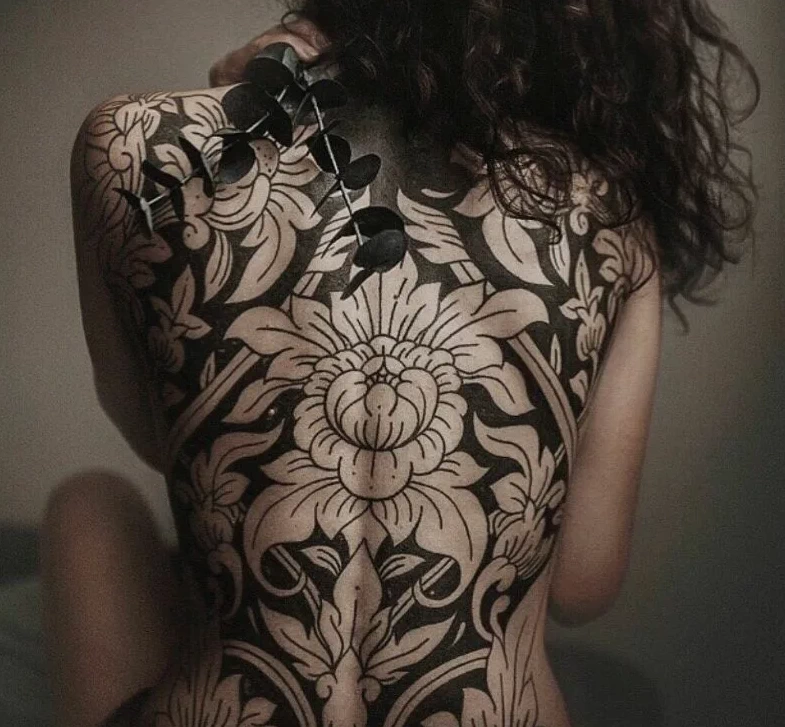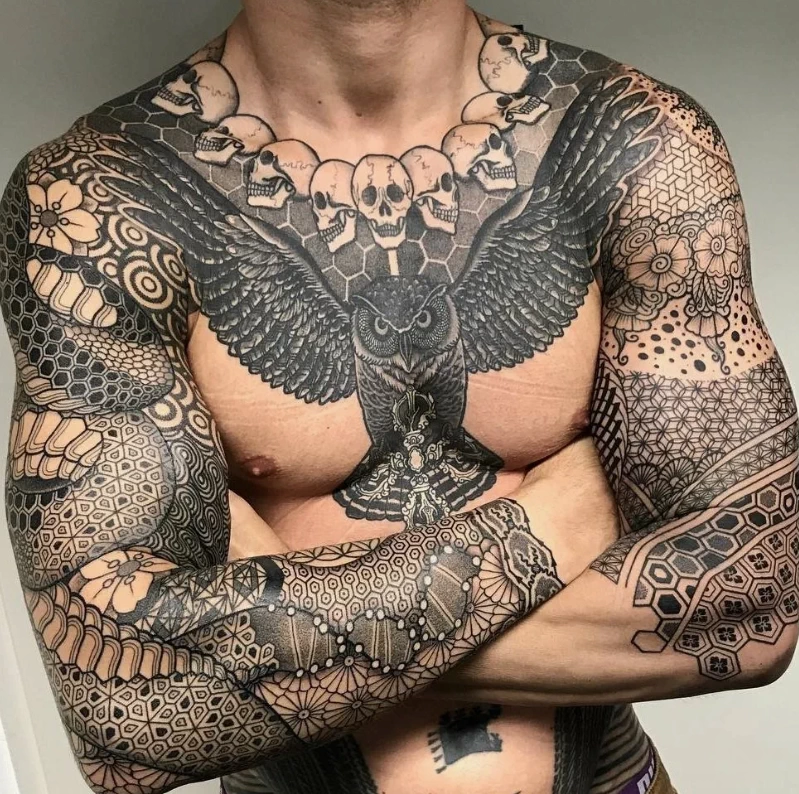Tattoos are often considered an integral part of personal identity, symbolizing important life moments or expressing deep beliefs. However, over time, our views, lifestyles, and even aesthetic preferences can change. This is when the desire to modify an existing tattoo arises. Many seek to refresh their tattoos to better reflect their current life situation or inner world, or because the original design no longer brings satisfaction or has lost its initial meaning. A tattoo is not just a skin decoration; it’s a form of self-expression that can evolve with the individual. The ability to change a tattoo provides a unique opportunity not only to correct past mistakes in design or execution but also to adapt tattoos to new life circumstances. Modern tattooing technologies and methods make the process of changing tattoos accessible and relatively painless, opening doors for creative self-expression throughout life.
REASONS FOR WANTING TO CHANGE A TATTOO
Changing personal beliefs or interests Over time, our beliefs, tastes, and interests can change significantly. Tattoos that were once important symbols or reflected certain aspects of our lives may become less relevant or even undesirable. For example, tattoos related to specific relationships, hobbies, or life stages may lose their meaning if a person undergoes significant changes in their personal life or career. In such cases, many choose to change their tattoos as a way to reflect their new self and current beliefs. Discontent with the initial result Sometimes the desire to change a tattoo arises from dissatisfaction with its initial execution. This may be related to the quality of work, where design details may have been executed inaccurately, or with the wrong choice of color, which may have faded or changed shade over time. Technical errors or unprofessionalism on the part of the tattoo artist can also lead to dissatisfaction, prompting people to seek ways to correct or completely cover up the unwanted result. Natural changes, such as skin stretching Physical changes in the body, such as skin stretching due to pregnancy, weight changes, or natural aging, can also affect the appearance of tattoos. Tattoos located on parts of the body where the skin is subject to significant changes may distort or lose their clarity. These changes may prompt either adapting the tattoo to the new body contours or completely changing the design to better complement the current condition of the skin and body shape. Reasons such as personal growth, dissatisfaction with past decisions, and physical changes underscore the dynamic nature of tattoos as a form of art and self-expression. They are not just decorations but living stories that evolve with us.
MAIN OPTIONS FOR CHANGING A TATTOO
Cover-up: Explanation of the process and examples of successful cover-ups Tattoo cover-up is a process where an old tattoo is replaced with a new one, often larger and more complex, to completely conceal the original design. This method is often chosen by those who want to get rid of tattoos that no longer reflect their beliefs or tastes, or contain design errors. The process requires high skill and a creative approach from the tattoo artist, as it is necessary to consider the color, shape, and size of the previous tattoo to successfully conceal it. Modern tattoo masters use various styles and techniques to make cover-ups look natural and aesthetic. Examples of successful cover-ups often include dark elements or more complex patterns that effectively mask old designs. Design correction: How minor changes can refresh or improve a tattoo Design correction is another option for those who want to change their tattoo without completely covering it up. This process may involve changing details, adding new elements, or enhancing color to improve the overall appearance of the tattoo. Correction is suitable for minor defects or when the client wants to add new elements to give the tattoo more depth or meaning. It is also a great way to refresh a tattoo that has faded or become distorted over time due to changes in the skin. Tattoo removal: Overview of removal methods and their effects on the skin For those who want to completely get rid of a tattoo, various removal methods are available. Laser therapy is the most popular and effective method, using concentrated light to break down ink in the skin. Laser technologies continue to evolve, offering more painless and less invasive procedures than ever before. Laser removal may require several sessions depending on the size, color, and age of the tattoo. After the procedures, it is important to properly care for the skin to ensure optimal healing and minimize risks. After completely removing the tattoo, the skin may need time to recover before a new tattoo can be made in the same area. Each of these methods offers different opportunities for changing or removing tattoos, allowing people to adapt their tattoos to changes in life or simply correct past mistakes. The choice of method depends on individual preferences, skin conditions, and the ultimate goal of changing the tattoo.
HOW TO CHOOSE THE RIGHT APPROACH FOR CHANGING A TATTOO
Tips for Consulting with Professional Tattoo Artists Choosing the appropriate method for changing a tattoo begins with consulting a qualified tattoo artist. This is an important step that will help determine the best course of action based on your unique design and skin condition. Here are a few tips on how to effectively interact with professionals:
- Explore portfolios – Before your visit, study the works of tattoo artists to ensure their style and execution quality. Choose an artist whose work impresses you and aligns with your vision for the future design.
- Clearly articulate your expectations – During the consultation, explain in detail what exactly you are dissatisfied with in the current tattoo and what changes you would like to see.
- Listen to expert opinions – Tattoo artists may suggest options you haven’t considered or explain potential risks associated with your desires.
- Discuss the procedure – Understanding all the steps of the procedure will help you prepare for the changes. Clarify how many sessions will be needed and how long the healing process will take.
Considering factors such as cost, time, and pain level When choosing a method for changing a tattoo, it is important to consider not only the aesthetic result but also other key factors:
- Cost – Laser tattoo removal or complex cover-ups can be expensive procedures. Evaluate your budget and inquire about preliminary costs from several specialists.
- Time – Some procedures require multiple sessions and extended healing time between them. Make sure your schedule allows you to allocate the necessary time for the entire course of procedures.
- Pain level – Changing a tattoo can be a painful process, especially if it involves laser removal or covering a large area. Discuss possible pain management methods with the artist and clarify what you should be prepared for.
Choosing the right method for changing a tattoo is a complex decision that should take into account both the desired visual result and the practical aspects of the process. A well-chosen plan of action will help ensure satisfaction with the new tattoo and comfort during its execution.
PREPARING FOR TATTOO CHANGES
Changing a tattoo is a significant process that requires not only a professional approach from the artist but also thorough preparation from the client. Preparation for changing a tattoo includes both physical and emotional components, each of which plays a key role in the successful outcome.
Physical preparation: How to prepare your skin for the procedure Physical preparation for changing a tattoo begins several weeks before the planned procedure and includes the following steps:
- Moisturizing the skin – Regular moisturizing helps maintain its elasticity and health, which is especially important before a cover-up or correction procedure. Use high-quality moisturizers that do not contain harmful additives or fragrances.
- Skin cleanliness – Keeping the skin clean helps prevent possible infections after the procedure. Regularly wash the area of the upcoming tattoo with mild antibacterial soap.
- Sun protection – Avoid prolonged exposure to sunlight on the tattoo area before the procedure, as this can damage the skin and hinder the healing process.
- Proper nutrition and hydration – Consuming an adequate amount of water and nutrient-rich foods promotes skin health and accelerates its recovery.
Emotional preparation: Mental preparation for changes in your appearance Emotional preparation also plays an important role, as changing a tattoo can touch on deep personal themes and memories:
- Psychological readiness for changes – Make sure you are fully prepared for changes in your appearance. This may involve rethinking the reasons why you are making changes and psychological readiness to embrace the new look.
- Consultations with loved ones – Discussing upcoming changes with friends or family can help you get support and possibly new ideas for tattoo design.
- Focus on a positive outcome – Maintain a positive attitude, focusing on upcoming changes as an opportunity to improve and refresh your tattoo.
Preparing for tattoo changes is a comprehensive process that requires attention to both physical and emotional aspects. Thorough preparation will help ensure that the process goes smoothly and yields the desired results, making your tattoo not only more beautiful but also more meaningful.
THE PROCESS OF CHANGING A TATTOO DESIGN
Changing a tattoo is a complex process that can involve covering up an existing design, making corrections, or complete removal. Each of these methods requires a specific approach and thorough preparation.
Stages of Tattoo Cover-Up: Covering up a tattoo begins with careful planning of the new design, which should harmoniously blend with the existing image while simultaneously concealing its flaws. The process includes the following stages:
- Consultation with the tattoo artist – Discussing possibilities and selecting a suitable design for covering up.
- Design preparation – Developing and adjusting the sketch, considering the size, color, and style of the old tattoo.
- Applying the new design – Tattoo application, which may require multiple sessions depending on the complexity and size of the new design.
- Healing – Tattoo care after the session, which is critically important for a quality result.
Correction of the Existing Tattoo: Correction may involve enhancing details, adding elements, or changing the color to refresh the old design. Correction stages include:
- Analysis of the original tattoo – Evaluation of existing elements and determining necessary changes.
- Making corrections – A process that may be less time-consuming but requires high precision and skill.
Tattoo Removal: If covering up or correction are not possible or undesirable, tattoo removal can be chosen. Laser removal is the most popular method, which includes:
- Consultation with a dermatologist or laser removal specialist – Discussion of expectations and planning the procedure.
- Laser treatment – The laser destroys pigment, allowing the body to naturally remove the ink.
- Treatment sessions – The need for multiple sessions, depending on the size, color, and age of the tattoo.
- Healing – Skin care between sessions and after completing all procedures.
The Importance of Post-Procedure Care: Regardless of the chosen method, post-procedure care after changing a tattoo plays a crucial role in healing quality and the final appearance of the tattoo. This includes:
- Cleanliness – Regular gentle cleansing of the tattoo area.
- Moisturizing – Use of special ointments or creams to maintain skin hydration.
- Avoiding sunlight and tight clothing – Protecting the tattoo from direct sunlight and preventing irritation from clothing.
- Monitoring healing – Observing for possible signs of infection or improper healing.
Approaching the tattoo changing process responsibly and consciously, you can not only correct past mistakes but also give your tattoo a new, more significant dimension.
CONCLUSION ON CHANGING A TATTOO DESIGN
The Importance of Careful Selection When Changing a Tattoo: Changing a tattoo is not just an aesthetic update but also a deeply personal process that can reflect significant changes in a person’s life. Therefore, it is extremely important to carefully approach the choice of method and artist for changing the tattoo. This decision should be thoughtful and based on a clear understanding of all available options – from covering up and correction to complete tattoo removal. Each of these methods has its own characteristics and potential risks, as well as offering unique opportunities for creative and personal self-expression.
Inspiring Words on the Opportunity for Transformation and Personal Growth Through Tattoo Changes: Tattoos are more than just skin art; they are mirrors of our history, beliefs, and aspirations. The opportunity to change a tattoo provides a unique chance not only to correct past mistakes but also to adapt these images to reflect our current life path and personal growth. This process can be a powerful means of self-expression and self-exploration, offering an opportunity to rethink and reassess our life choices.
Changing a tattoo is also a reminder that nothing in life is absolutely permanent, and there is always room for change, growth, and new beginnings. It is a manifestation of flexibility and adaptability, the ability of a person to transform and renew. That is why the process of changing a tattoo can become not only a path to improving appearance but also a catharsis, contributing to deep personal development and self-awareness.
Thus, the choice to change a tattoo is a significant step that deserves attention and respect. This decision can have a profound impact on self-esteem and self-perception, highlighting the beauty of personal development and evolution through art.





